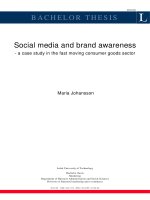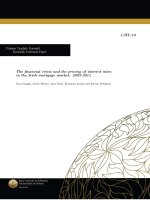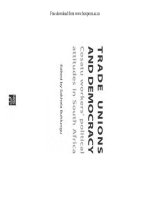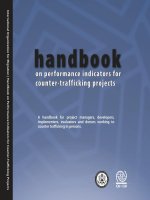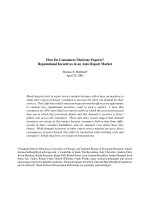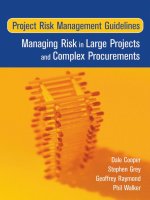giot and grammig-how large is liquidity risk in an automated auction market
Bạn đang xem bản rút gọn của tài liệu. Xem và tải ngay bản đầy đủ của tài liệu tại đây (610.31 KB, 32 trang )
How large is liquidity risk in an automated auction
market?
Pierre Giot
Joachim Grammig
∗
September 21, 2002
ABSTRACT
We introduce a new empirical methodology that takes account of liquidity risk
in a Value-at-Risk framework, and quantify liquidity risk premiums for portfolios
and individual stocks traded on the automated auction market Xetra which oper-
ates at various European exchanges. When constructing liquidity risk measures we
allow for the potential price impact incurred by the liquidation of a portfolio. We
study the sensitivity of liquidity risk towards portfolio size and VaR time horizon,
and interpret its diurnal variation in the light of market microstructure theory.
∗
Pierre Giot is from Department of Business Administration & CEREFIM at University of Na-
mur, Rempart de la Vierge, 8, 5000 Namur, Belgium. Phone: +32 (0) 81 724887. Email:
Joachim Grammig is from the Swiss Institute of Banking and Finance, Uni-
versity of St. Gallen, Rosenbergstr. 52, CH-9000 St. Gallen, Switzerland. Phone: +41 71 224 70 90.
Fax: +41 71 224 7088. Email: Both authors are research fellows at CORE,
Universit´e Catholique de Louvain, Belgium. We are grateful to Deutsche Boerse AG for providing ac-
cess to the limit order data and to Kai-Oliver Maurer and Uwe Schweickert who provided invaluable
expertise regarding the Xetra trading system, as well as Rico von Wyss and Michael Genser who offered
helpful comments. We also thank Helena Beltran-Lopez for her cooperation in the preparation of the
datasets and Bogdan Manescu for research assistance.
According to the 1988 Basel Accord the total (market risk) capital requirement for a
financial institution is the sum of the requirements of positions in four different categories
which are equities, interest rates, foreign exchange and gold and commodities. This sum
is a major determinant of the eligible capital of the financial institution based on the
8% rule. The 1996 Amendment proposed an alternative approach for determining the
market risk capital requirement, allowing the use of an internal model (subject to strong
qualitative and quantitative requirements) in order to compute the maximum loss over
10 trading days at a 1% confidence level. This set the stage for Value-at-Risk models
which can be broadly defined as quantitative tools designed to assess the possible loss
that can be incurred by a financial institution over a given time period and for a given
portfolio of assets.
1
In this pap er we propose a new empirical methodology that explicitly accounts for
liquidity risk when computing VaR measures. Using data from the automated auction
system Xetra we investigate the dependence of liquidity risk on portfolio size and VaR
time horizon, and interpret intra-day variations of liquidity risk premiums in the light
of market microstructure theory.
In economics and finance, the notion of liquidity is generally conceived as the ability
to trade quickly a large volume with minimal price impact. In an attempt to grasp the
concept more precisely, Kyle (1985) identifies three dimensions of liquidity: tightness
(reflected in the bid-ask spread), depth (the amount of one-sided volume that can be
absorbed by the market without causing a revision of the bid-ask prices), and resiliency
(the speed of return to equilibrium). Liquidity aspects enter the Value-at-Risk method-
ology quite naturally. The VaR approach is built on the hypothesis that “market prices
represent achievable transaction prices” (Jorion, 2000). In other words, the prices used
to compute market returns in the VaR models have to be representative of market con-
ditions and traded volume. Consequently, the price impact of portfolio liquidation has
to be taken into account. The debacle of the Long-Term Capital Management hedge
1
fund has shown that the price impact of the liquidation can be substantial and failing
to account of liquidity risk might even stir economies as a whole.
2
However, empirical
VaR analyses undertaken by academics and practitioners continue to use in almost all
cases mid-quote prices as inputs, and disregard potential liquidity risk. Some recent
contributions to the VaR literature have begun to address this issue. Subramanian and
Jarrow (2001) characterize the liquidity discount (the difference between the market
value of a trader‘s position and its value when liquidated) in a continuous time frame-
work. Empirical models incorporating liquidity risk are developed in Jorion (2000), or
Bangia, Diebold, Schuermann, and Stroughair (1999), but none of the methods does
explicitly take into account the price impact incurred when liquidating a portfolio of
assets. Instead, liquidity risk is approximated by and derived from the volatility of the
inside spread (the difference between the best bid and ask price).
In this paper we will show that with suitable data at hand, the VaR can be ad-
justed for liquidity risk by explicitly modeling the price impact incurred by a trade of
a given volume. In contrast to a standard (frictionless) VaR approach, in which one
uses prices based on mid-quotes, the
Actual VaR approach pursued in this paper uses
as inputs volume-dependent transaction prices. This takes into account the fact that
buyer (seller) initiated trades incur increasingly higher (lower) prices per unit share as
the trade volume increases. The VaR liquidity risk component naturally originates from
the volume dependent price impact incurred when the portfolio is liquidated. The Ac-
tual Var approach relies on the availability of intra-day bid and ask prices valid for the
immediate trade of any volume of interest. Admittedly, procuring such data from tradi-
tional market maker systems would be an extremely tedious task. However, the advent
of modern automated auction systems offers a new possibilities for empirical research.
Using a unique database containing records of all relevant events occurring in an auto-
mated auction system, we construct real-time order book histories over a three-month
period and compute time series of potential price impacts incurred by trading a given
2
portfolio of assets. Based on this data we estimate liquidity adjusted VaR measures and
liquidity risk premiums for portfolios and single assets.
Our empirical results reveal a pronounced diurnal variation of liquidity risk which is
consistent with predictions of microstructure information models. We show that when
assuming a trader’s perspective, accounting for liquidity risk becomes a crucial factor:
the traditional (frictionless) measures severely underestimate the true VaR. When the
VaR time horizon is increased assuming the regulator’s perspective defined in the Basel
Accord, liquidity risk is reduced compared to market risk, albeit remaining an econom-
ically significant factor as far as medium and large portfolios are concerned.
The remainder of the paper is organized as follows: In Section I, we provide back-
ground information about the organization of automated auction systems in general, and
the Xetra system in particular. Section II describes our data set. The empirical method
is developed in Section III. Results are reported in Section IV. Section V concludes and
offers possible new research directions.
I. Market structure
In a dealership market, one or more dealers/market makers act as suppliers of liquidity.
Market microstructure theory shows how inventory and asymmetric information effects
account for the fact that the market maker’s quotes and depths − two of Kyle’s liquidity
dimensions −
become progressively less favorable as the traded volume increases (see
O’Hara (1995) and Madhavan (2000) for reviews). Because no dedicated market makers
are present in modern automated auction markets, liquidity supply solely depends on the
state of the electronic order book which consists of previously entered, non-executed limit
buy and sell orders. This set of standing orders determines the price-volume relationship
that a trader who requires immediacy of execution is facing. If few limit buy or sell orders
are present in the system or if many orders are present but are valid only for small trade
3
sizes, liquidity is low and trades may incur considerable price impacts. Because of
the price and time priority rules implemented at automated auction markets, the price
impact of a buy (sell) side trade is an increasing (decreasing) function of the trade size.
Studying the Swedish stock index futures market Coppejans, Domowitz, and Madhavan
(2001) consider as a key statistic for measuring liquidity the unit price obtained when
selling v shares at time t
:
b
t
(
v
) =
k
b
k,t
v
k,t
v
(1)
where
v
is the volume executed at
k
different unique bid prices b
k,t
with corresponding
volumes
v
k,t
standing in the limit order book at time
t
. This simple measure is able
to meet Kyle’s requirements for a liquidity measure by accounting simultaneously for
tightness, depth and, by studying its time series dynamics, resiliency.
3
In our empirical analysis we will use data from the automated auction system Xetra
which is employed at various European trading venues, like the Vienna Stock Exchange,
the Irish Stock Exchange and the European Energy Exchange. Xetra was developed and
is maintained by the German Stock Exchange and has operated since 1997 as the main
trading platform for German blue chip stocks at the Frankfurt Stock Exchange (FSE).
Whilst there still exist market maker systems operating parallel to Xetra - the largest
of which being the Floor of the Frankfurt Stock Exchange- the importance of those
venues has been greatly reduced, especially regarding liquid blue chip stocks. Similar
to the Paris Bourse’s CAC and the Toronto Stock Exchange’s CATS trading system, a
computerized trading protocol keeps track of entry, cancellation, revision, execution and
expiration of market and limit orders. Until September 17, 1999, Xetra trading hours
at the FSE extended from 8.30 a.m to 5.00 p.m. CET. Beginning with September 20,
1999 trading hours were shifted to 9.00 a.m to 5.30 p.m. CET. Between an opening
and a closing call auction - and interrupted by a another mid-day call auction - trading
is based on a continuous double auction mechanism with automatic matching of orders
4
based on clearly defined rules of price and time priority. Only round lot sized orders
can be filled during continuous trading hours. Execution of odd-lot parts of an order
(representing fractions of a round lot) is possible only in a call auction. During pre- and
post-trading hours it is possible to enter, revise and cancel orders, but order executions
are not conducted, even if possible.
According to a taxonomy introduced by Domowitz (1992) Xetra may be described as
a “hit and take” system.
4
Until Octob er 2000, Xetra screens displayed not only best bid
and ask prices, but the whole content of the order book to the market participants. This
implies that liquidity supply and potential price impact of a market order (or marketable
limit order) were exactly known to the trader. This was a great difference compared to
e.g. Paris Bourse’s CAC system where “hidden” orders (or “iceberg” orders) may be
present in the order book. As the name suggests, a hidden limit order is not visible in
the order book. This implies that if a market order is executed against a hidden order,
the trader submitting the market order may receive an unexpected price improvement.
Iceberg orders were allowed in Xetra in October 2000, heeding the request of investors
who were reluctant to see their (potentially large) limit orders, i.e. their investment
decisions, revealed in the open order bo ok.
The transparency of the Xetra order book does not extend to revealing the identity
of the traders submitting market or limit orders. Instead, Xetra trading is completely
anonymous and dual capacity trading, i.e. trading on behalf of customers and principal
trading by the same institution is not forbidden.
5
In contrast to a market maker system
there are no dedicated providers of liquidity, like e.g. the NYSE specialists, at least not
for blue chip stocks studied in this paper. For some small cap stocks listed in Xetra there
may exist so-called Designated Sponsors - typically large banks - who are obliged, but
not forced to, provide a minimum liquidity level by simultaneously submitting competing
buy and sell limit orders.
5
II. Data
The German Stock Exchange granted access to a database containing complete informa-
tion about Xetra open order book events (entries, cancellations, revisions, expirations,
partial-fills and full-fills of market and limit orders) that occurred between August 2,
1999 and October 29, 1999.
6
Due to the considerable amount of data and processing
time, we had to restrict the number of assets we deal with in this study. Event histories
were extracted for three blue chip stocks, DaimlerChrysler (DCX), Deutsche Telekom
(DTE) and SAP. By combining these stocks we form small, medium and large portfolios
as it could be argued that estimating the Value-at-Risk is interesting not so much at
stock level, but on the level of (well-diversified) portfolios. At the end of the sample
period the combined weight of DaimlerChrysler, SAP and Deutsche Telekom in the DAX
- the value weighted index of the 30 largest German stocks - amounted to 30.4 percent
(October 29, 1999). Hence, the liquidity risk associated with the three stock portfolios
is quite representative of the liquidity risk that an investor faces when liquidating the
market portfolio of German Stocks.
Based on the event histories we perform a real time reconstruction of the order
book sequences. Starting from an initial state of the order book, we track each change
in the order book implied by entry, partial or full fill, cancellation and expiration of
market and limit orders. This is done by implementing the rules of the Xetra trading
protocol outlined in Deutsche B¨orse AG (1999) in the reconstruction program.
7
From the
resulting real-time sequences of order bo oks snapshots at 10 and 30-minute frequencies
during the trading hours were taken. For each snapshot, the order book entries were
sorted on the bid (ask) side in price descending (price ascending) order. Based on the
sorted order book sequences we computed the unit price
b
t
(v
), as defined in Equation (1),
implied by selling at time t volumes
v
of 1, 5,000, 20,000, and 40,000 shares, respectively.
Mid-quote prices were computed as the average of best bid and ask prices prevailing at
time t
. Of course these are equivalent to b
t
(1) and a
t
(1), respectively. If the trade
6
volume
v
exceeds the depth at the prevailing best quote then
b
t
(v
) will be smaller than
b
t
(1) (and
a
t
(v) > a
t
(1)). By varying the trade volume v
one can plot the slope of the
instantaneous offer and demand curves.
III. Methodology
Bangia, Diebold, Schuermann, and Stroughair (1999) (henceforth referred to as BDSS)
suggest a liquidity risk correction procedure for the Value-at-Risk framework. BDSS
relate the liquidity risk component to the distribution of the inside half-spread. In
the first step of the procedure, the VaR is computed as the α
percent quantile of the
mid-quote return distribution (assuming normality). This quantile is then increased
by a factor based on the excess kurtosis of the returns. In a second step, liquidity
cost is allowed for by taking as inputs the historical average half-inside-spread and its
volatility. This adjusts the VaR for the fact that buy and sell orders are not executed
at the quote mid-point, but that (extreme) variations in the spread may occur. BDSS
assume a perfect correlation between the frictionless VaR and the exogenous cost of
liquidity. This yields the total VaR being equal to the sum of the market VaR and
liquidity cost. Switching from returns to price levels, BDSS express the VaR at level α
(including liquidity costs) as:
P
t
=
a
t
(1) + b
t
(1)
2
(1 −e
µ+
Z
α
σ
) +
1
2
(
µ
S
+
Z
α
σ
S
)
(2)
where
µ
and
σ are the mean and volatility of the market (mid-quote) returns, µ
S
and σ
S
are the mean and volatility of the relative spread,
Z
α
and
Z
α
are the α percent quantiles
of the distribution of market returns and spread respectively and P
t
is the VaR at level
α (expressed as a price) taking into account market risk and liquidity costs.
The BDSS procedure offers the possibility to allow for VaR liquidity risk when only
best bid best ask prices are available. This is, for example, the case when using the
7
popular TAQ data supplied by NYSE. A volume dependent price impact is, quite delib-
erately, not taken into account as such information cannot be procured from standard
databases. However, a more precise way to allow for liquidity risk becomes feasible with
richer data at hand. The approach pursued in this paper relies on the availability of
time series of intra-day bid and ask prices valid for the immediate trade of a given vol-
ume. In a market maker setting this requires a time series of quoted bid and ask prices
for a given volume. In an automated auction market, unit bid and ask prices can be
computed according to Equation (1) using open order book data. Obtaining such data
for a market maker system will be almost impossible. As market makers are obliged
to quote only best bid and ask prices with associated depths, quote driven exchanges
can and will at best supply this limited information set for financial market research.
As a matter of fact, this is the situation where the BDSS approach adds the greatest
value in correcting VaR for liquidity risk. In a computerized auction market much richer
data can be exploited. As the automated trading protocol keeps track of and records all
events occurring in the system it is possible to reconstruct real time series of limit order
books from which the required unit bid prices b
t
(
v) can be straightforwardly computed.
In order to compute the liquidity risk measures to be introduced below, econometric
specifications for two return processes are required. First, for mid-quote returns (referred
to as
frictionless
returns) which are defined as the log ratio of consecutive mid-quotes:
8
r
mm,t
= ln
a
t
(1) +
b
t
(1)
a
t
−
1
(1) + b
t−
1
(1)
.
Second, for actual returns which are defined as the log ratio of mid-quote and consecutive
unit bid price valid for selling a volume
v shares at time t:
r
mb,t
(
v
) = ln
b
t
(
v
)
0.
5(
a
t−1
(1) + b
t−
1
(1))
.
8
For the analysis of liquidity risk associated with a portfolio consisting of
i
= 1
, . . . , N
assets with volumes
v
i
, actual returns are obtained by computing the log ratio of the
market value when selling the portfolio at time t,
N
i
=1
b
t
(
v
i
)v
i
, and the value of the
portfolio evaluated at time t
− 1 mid-quote prices. To compute frictionless portfolio
returns, the portfolio is evaluated at mid-quote prices both at
t and
t
−
1.
For both types of returns the VaR is estimated in the standard way, namely as the
one-step ahead forecast of the
α
percent return quantile. We refer to the VaR computed
on the
{r
mb,t
(
v)
}
T
t=1
returns sequence as the Actual VaR. Our econometric specifications
of the return processes build on previous results on the statistical properties of intra-day
spreads and return volatility. Two prominent features of intra-day return and spread
data have to be accounted for. First, spreads feature considerable diurnal variation (see
e.g. Chung, Van Ness, and Van Ness (1999)). Microstructure theory suggests that inven-
tory and asymmetric information effects play a crucial role in procuring these variations.
Information models predict that liquidity suppliers (market makers, limit order traders)
widen the spread in order to protect themselves against potentially superiorly informed
trades around alleged information events, such as the open. Second, as shown by e.g.
by Andersen and Bollerslev (1997), conditional heteroskedasticity and diurnal variation
of return volatility have to be taken into account. When specifying the conditional
mean of the actual return processes we therefore allow for diurnal variations in actual
returns, since these contain, by definition, the half-spread. We adopt the specification
of Andersen and Bollerslev (1997) to allow for volatility diurnality and conditional het-
eroskedasticity in the actual return process. Furthermore, diurnal variations in mean
returns and return volatility are assumed to depend on the trade volume, as suggested
by Gouri´eroux, Le Fol, and Jasiak (1999). For convenience of notation we suppress the
volume dependence of actual returns and write the model as:
r
mb,t
= ψ
t
+ δ
0
+
r
i=1
δ
i
r
mb,t−i
+
u
t
(3)
9
where
u
t
=
φ
t
h
t
t
(4)
h
t
=
ω
+
q
i=1
α
i
u
2
t
−
i
+
p
i
=1
β
i
h
t
−
i
.
(5)
The innovations
t
are assumed to be independently identically Student distributed with
ν
1
degrees of freedom. The functions ψ
t
and φ
t
account for diurnal variation in the level
of actual returns and return volatility, respectively. We have suppressed the volume
dependence of actual returns only for brevity of notation. The discerning reader will
recognize that in a more extensive notation all greek letters would have to be written
with a volume index
v
. Accordingly, the model parameters are estimated for each volume
dependent actual return process. We employ a four-step procedure that is described as
follows.
First, the diurnal component ψ
t
is estimated by a non-parametric regression ap-
proach. Given returns available at s
-minute sampling frequency, we sub-divide the
trading day into s
-minute bins, compute the average actual return (over all days in
the sample) by bin and smooth the resulting time series using the Nadaraya-Watson
estimator.
9
In the second step, a time series of diurnally adjusted returns is obtained by
subtracting the estimate
ˆ
ψ
t
from the actual return
r
mb,t
. The resulting time series is used
to estimate the AR-parameters process by OLS. The sequence of AR residuals provides
the input for modelling actual return volatility. In the third step, the diurnal volatility
function
φ
t
is estimated non-parametrically by applying the Nadaraya-Watson estimator
to the estimated squared AR residuals,
{ˆ
u
2
t
} which are sorted in
s
-minute bins. In step
four, the squared AR residuals are divided by the estimates
ˆ
φ
t
. The resulting series is
finally used to estimate the GARCH parameters by conditional Maximum Likelihood.
10
10
This specification implies that the conditional standard deviation of the actual return
at time t
,
σ
t
(r
mb,t
(
v)), evolves as:
σ
t
(
r
mb,t
) =
φ
t
h
t
.
(6)
The Actual VaR at time t
−
1 for the actual return at time
t given confidence level
α is
then given by:
V aR
mb,t
=
µ
mb,t
+ t
α,ν
1
σ
t
(
r
mb,t
) (7)
where
µ
mb,t
=
ψ
t
+ δ
0
+
r
i=1
δ
i
(
r
mb,t
−
i
− ψ
t−
i
))
and
t
α,ν
1
is the
α
−percent quantile of the Student distribution with
ν
1
degrees of
freedom.
11
We refer to
µ
mb,t
as the mean component and to
t
α,ν
1
σ
t
(r
mb,t
) as the volatility
component of the Actual VaR.
The computation of the liquidity risk premium measures which will be discussed
below also requires a VaR estimate based on mid-quote returns (referred to as frictionless
VaR). The econometric specification corresponds to the Actual VaR with the exception
that there is no need to account for a diurnal variation in mean returns.
12
For notational
convenience let us use the same greeks as for the actual return specification:
r
mm,t
=
µ
mm,t
+
u
t
(8)
µ
mm,t
= δ
0
+
r
i
=1
δ
i
r
mm,t
−i
u
t
=
φ(
t
)
h
t
t
h
t
=
ω
+
q
i
=1
α
i
u
2
t−i
+
p
i
=1
β
i
h
t
−i
.
11
The innovations
t
are assumed to be independently identically Student distributed with
ν
2
degrees of freedom. φ
t
accounts for diurnal variation in frictionless return volatility.
Parameter estimation is performed along the same lines as outlined above. The friction-
less VaR at α percent confidence level is:
V aR
mm,t
= µ
mm,t
+
t
α,ν
2
σ
t
(
r
mm,t
). (9)
where
σ
t
(r
mm,t
) =
φ
(t
)
h
t
. As above we refer to the two terms on right hand side of
Equation (9) as mean and volatility component of the frictionless VaR.
We propose to quantify liquidity risk by comparing frictionless and Actual VaR. Two
liquidity risk premium measures are used, one based on the difference, the other on the
ratio of frictionless and Actual VaR:
Λ
t
= V aR
mm,t
−
V aR
mb,t
(10)
λ
t
=
Λ
t
V aR
mm,t
. (11)
Omitting the economically negligible mean component of the frictionless VaR, we can
rearrange Equation (11) and write the relative liquidity risk premium as:
λ
t
=
µ
mb,t
t
α,ν
2
σ
t
(
r
mm,t
)
+
t
α,ν
1
σ
t
(
r
mb,t
)
t
α,ν
2
σ
t
(
r
mm,t
)
−
1
.
(12)
Equation (12) shows that
λ
t
can be conceived as the sum of two terms naturally referred
to as mean and volatility component of the (relative) liquidity risk premium. Note that
in a more extensive notation, one would write the dependence of both liquidity premiums
on portfolio size
v
and confidence level α
.
We want to stress two points before applying the liquidity measures Λ
t
and
λ
t
.
First,
λ
t
is, by definition, a relative, conditional measure. If the VaR horizon is short
and the volatilities of both actual and frictionless returns are relatively small and of
12
comparable size then the mean component of the Actual VaR will be the most important
determinant of λ
t
. Ceteris paribus, the importance of the actual return mean component
will increase with trade volume and so will both liquidity risk premium measures. At
longer VaR horizons, both actual and frictionless return volatility will naturally increase
due to non-liquidity related market risk. This reduces the relative importance of the
λ−mean component as the denominator of the first term in Equation (12) grows. If
both actual and frictionless return volatility increase by the same factor then the relative
liquidity risk premium is expected to approach zero at longer VaR horizons. Second,
when studying intra-day variations of the liquidity risk premium the difference measure
Λ
t
is more appropriate. Both spreads and volatility of intra-day returns are expected
to exhibit diurnal variation. By construction, small changes in the intra-day frictionless
return volatility may exert a considerable impact on the diurnal variation of λ
t
, whilst
Λ
t
is robust against such fluctuations.
IV. Empirical results
A. Parameter estimates
The Nadaraya-Watson, OLS and Maximum likelihood estimates are obtained using
GAUSS procedures written by the authors. Table I reports the estimates of the paramet-
ric model part (AR-GARCH parameters) based on 10-minute returns of equal volume
stock (EVS) portfolios and individual stocks. Table III (deferred to the appendix) con-
tains the half-hour frequency results.
13
An EVS portfolio contains the same number
of shares for each stock in the portfolio. We will henceforth generally use the notion
portfolio both for EVS portfolios and single stocks, conceiving the latter as a portfolio
containing only a single stock. We report results on small volume (v = 5, 000), medium
volume (
v
= 20,
000) and big volume (v
= 40, 000) portfolios. Based on the Schwarz-
Bayes-Criteria and Ljung-Box statistics, AR(1)-GARCH(1,1) (half-hour frequency) and
13
AR(3)-GARCH(1,1) (10-minute frequency) specifications were selected. Whilst the AR
parameter estimates and the Ljung-Box statistics computed on raw returns indicate only
small autocorrelations of frictionless returns (as expected in an at least weakly efficient
market) , the serial dependence of the actual returns on the medium and big portfolios
is more pronounced. This results holds true especially at the higher frequency and indi-
cates that persistence in spreads increase with trade volume. After accounting for mean
diurnality and serial dependence in actual returns the AR residuals do not display signif-
icant autocorrelations. Comparing the Ljung-Box statistic before and after accounting
for conditional heteroskedasticity and volatility diurnality reveals that the model does
a good job in reducing serial dependence in squared returns. The GARCH parameter
estimates and degrees of freedom are quite stable across portfolio sizes and their order
of magnitude is comparable to what is found when estimating GARCH models on intra-
day returns (see Andersen and Bollerslev (1997)). Based on the estimation results we
compute frictionless and Actual VaR at
α = 0
.05 as well as the sequence of relative and
difference liquidity measures Λ
t
and λ
t
.
Insert Table I about here.
B. The diurnal variation of liquidity risk
For the purpose of studying intra-day variation of liquidity risk we take sample averages
of the difference measure Λ
t
by time of day t
, smooth the resulting series by applying
the Nadaraya-Watson estimator, and investigate its diurnal variation during trading
hours. Figure 1 displays the considerable diurnal variation of the liquidity risk premium
especially for big portfolios. Liquidity risk is highest at the start of the trading day
and sharply declines during the next two hours whilst remaining at a constant level
throughout the remainder of the trading day. This pattern is stable across both sample
sub-periods with different trading hours. A trader who plans to sell large volumes at
14
the start of the trading day is expected to incur a significant price impact, i.e. has to be
ready to pay a considerable liquidity risk premium. The diversification effect smoothes
the intra-day variation, but the pronounced liquidity risk premium during the first half
hours after the open cannot be diversified away.
Insert Figure 1 about here.
Figure 2 details this finding by displaying the intra-day variation of mean and volatil-
ity component of the Actual VaR for the big EVS portfolio (
v = 40
,
000).
14
Both mean
and volatility component contribute to the diurnal variation of the Actual VaR and
hence to the time-of-day pattern of the liquidity risk premium. In the afternoon, NYSE
pre-trading exerts an effect on volatility component of both frictionless and Actual VaR,
but as both VaR measures are affected by the same order of magnitude, the liquidity
risk premium is not affected.
Insert Figure 2 about here.
The intra-day pattern of the liquidity risk premium and Actual VaR provides ad-
ditional empirical support for the information models developed my Madhavan (1992)
and Foster and Viswanathan (1994). Madhavan (1992) considers a model in which in-
formation asymmetry is gradually resolved throughout the trading day implying higher
spreads at the opening. In the Foster and Viswanathan (1994) model, competition be-
tween informed traders leads to high return volatility and spreads at the start of trading.
Analyzing NYSE intra-day liquidity patterns using the inside spread, Chung, Van Ness,
and Van Ness (1999) have argued that the high level of the spread at the NYSE opening
and its subsequent decrease provides evidence for the information models `a la Mad-
havan and Foster/Viswanathan. Accordingly, the diurnal variation of liquidity risk is
consistent with the predictions implied by those models. Due to alleged information
asymmetries, liquidity suppliers are initially cautious, i.e. the liquidity risk premium is
15
large. As the information becomes gradually incorporated during the trading process,
the liquidity risk premium decreases with increasing liquidity supply.
C. Unconditional liquidity risk premiums from traders’ and reg-
ulators’ perspective
The aftermath of the LTCM debacle showed that disregard of liquidity risk associated
with intra-day trading of large volumes can lead to devastating results even from a
macroeconomic perspective. Let us assess the importance of short term liquidity risk
in the present sample. The relative liquidity risk measure λ
as well as the difference
measure Λ are defined as conditional measures given information at time t
−1. One can
estimate the unconditional
liquidity risk premium λ = E(
λ
t
) by taking sample averages
¯
λ = T
−1
T
t
=1
λ
t
=
T
−1
T
t=1
µ
mb,t
t
α,ν
2
σ
t
(r
mm,t
)
+
T
−
1
T
t
=1
t
α,ν
1
σ
t
(
r
mb,t
)
t
α,ν
2
σ
t
(r
mm,t
)
−
1
. (13)
and study the dependence of the unconditional liquidity risk premium on the size
of the portfolio to be liquidated. Equation 13 shows that the decomposition of the
relative liquidity risk premium
λ
t
into mean and volatility component remains valid for
the unconditional liquidity risk premium, too.
Insert Table II about here.
Table II reports the estimated unconditional liquidity risk premium
¯
λ
. The decom-
position into mean and volatility component is contained in Table IV. The results show
that taking account of liquidity risk at the intra-day level is quite crucial. Even at
medium portfolio size, the liquidity risk premium is considerable. At half-hour horizon
the underestimation of the VaR of the medium EVS portfolio amounts to 34 percent.
For the big EVS portfolio the VaR is underestimated at half-hour horizon by 61 percent.
16
At the shorter horizon the underestimation becomes even more severe with the medium
EVS portfolio’s VaR being underestimated by 68 percent. The decomposition exercise
shows that when increasing portfolio size the volatility component of the liquidity risk
premium remains small relative to the mean component since the price impact incurred
by trading a large portfolio becomes the dominating factor. The relative liquidity risk
premium decreases, ceteris paribus, at the longer VaR horizon. The reason is that
both the frictionless and the Actual VaR’s volatility component obey the square root
of time rule, and increase (in absolute terms) by about the same order of magnitude.
This reduces the significance of the mean component while the order of magnitude of
the volatility component remains approximately constant. In other words, market risk
compared to liquidity risk becomes more important at longer horizons.
Because of the nature of portfolio liquidation in the banking industry, the time hori-
zon for VaR mo dels considered in the Basel Accord has been a longer one. From a
regulatory point of view one could therefore be interested in assessing the economic sig-
nificance of the liquidity risk factor at the one and ten-day VaR time horizon. Referring
to the square root of time rule one could use a high frequency estimate (e.g. 10-minute
frequency) of frictionless and Actual VaR and multiply the volatility components by a
factor
√
f that scales short horizon into long horizon volatility.
15
For example, when
half-hour frequency estimates are available, and one wants to assess the liquidity risk
premium at the one-hour horizon then f
= 2. Taking, as before, sample averages one
can approximate the unconditional relative liquidity premium at the desired frequency
by
¯
λ =
T
−1
T
t
=1
µ
mb,t
t
α,ν
2
√
fσ
t
(
r
mm,t
)
+
T
−1
T
t=1
t
α,ν
1
√
fσ
t
(
r
mb,t
)
t
α,ν
2
√
fσ
t
(
r
mm,t
)
−
1.
(14)
If VaR horizon and sampling frequency coincide then
f
= 1. Hence, we did not change
the notation and continue to write
¯
λ
to denote unconditional liquidity risk premiums.
We apply the approximation formula to the one and ten-day horizons using the half hour
Actual VaR estimates as a basis and scale to daily (
f
= 17) and ten day horizon (
f
=
17
170). The results reported in Table IV indicate that the relative importance of liquidity
risk premium is reduced at longer horizons, since market risk dominates liquidity risk.
Yet, liquidity risk remains economically significant for larger portfolios. Disregarding
liquidity risk, the one-day VaR estimate for the big EVS portfolio is underestimated
by 12 percent, a non-negligible amount from the regulatory perspective. At the 10-day
horizon, the underestimation is further reduced to 2 percent.
16
V. Conclusion and outlook
This paper quantified liquidity risk in an automated auction market by employing a
new empirical technique which extends the classical, frictionless VaR methodology. The
notion of an Actual VaR measure was introduced which takes account of the potential
price impact of liquidating a portfolio. Liquidity risk measures were proposed that are
defined on the difference and ratio of Actual and standard (frictionless) VaR. It was
argued that automated auction markets, in which a computer manages order entry and
matching, provide suitable and accurate data for the task of estimating the Actual VaR.
In order to measure liquidity risk using the methodology pursued in this paper one
has to provide a real time limit order bo ok reconstruction from which price impacts
of trading a given volume can be computed. Using data from the automated auction
system Xetra liquidity risk was quantified both for portfolios and for individual stocks.
The dependence of liquidity risk premiums on time-of-day, trade volume and VaR time
horizon was outlined.
The analysis revealed a pronounced diurnal variation of the liquidity risk premium.
The peak of the liquidity risk premium at the open and its subsequent decrease is
consistent with the predictions of the microstructure information models considered by
Madhavan (1992) and Foster and Viswanathan (1994). The results show that when
assuming a trader’s perspective, accounting for liquidity risk becomes a crucial factor:
18
the traditional (frictionless) measures severely underestimate the Value-at-Risk. This
result is the more pronounced the bigger the p ortfolio size and the shorter the time
horizon. When the VaR time horizon is increased to the regulator’s perspective given
in the Basel Accord, the relative importance of liquidity risk is reduced compared to
market risk, albeit remaining an economically significant factor as far as medium and
large portfolios are concerned.
Avenues for further research stretch in several directions. In the classification of
Dowd (1998), this paper has focused on the normal liquidity risk in contrast to crisis
liquidity risk. The latter refers to situations where “a market can be very liquid most
of the time, but lose its liquidity in a major crisis” (Dowd, 1998). The methodology
applied in this paper could be readily used to evaluate crisis liquidity risk using intra-day
data specific to such crisis periods where liquidity dried up for a few days/weeks (for
example during the Asian crisis of the summer months of 1997 or close to the LTCM
debacle in September 1998). Second, in a cross section study for a larger collection of
stocks one could relate liquidity risk premiums to firm-specific characteristics like e.g.
the equity-debt ratio. This would facilitate investigating the question whether corp orate
financing decisions or ownership structure affect firm specific liquidity risk.
References
Andersen, T.G., and T. Bollerslev, 1997, Intraday periodicity and volatility persistence
in financial markets, Journal of Empirical Finance
4, 115–158.
Bangia, A., F.X. Diebold, T. Schuermann, and J.D. Stroughair, 1999, Modeling liquidity
risk, with implications for traditional market risk measurement and management, The
Wharton Financial Institutions Center WP 99-06.
Bauwens, L., and P. Giot, 2001, Econometric modelling of stock market intraday activity.
(Kluwer Academic Publishers).
19
Beltran, H., P. Giot, and J. Grammig, 2002, Expected and unexpected cost of trading
in the XETRA automated auction market, Mimeo, CORE.
Biais, B., P. Hillion, and C. Spatt, 1999, Price discovery and learning during the pre-
opening period in the Paris Bourse, Journal of Political Economy 107, 1218–1248.
Buhl, C., and R. von Wyss, 2002, Exogenous liquidity in the Value at Risk concept,
Mimeo, Universities of Basel and St. Gallen.
Campbell, J. Y., A. W. Lo, and A. C. MacKinlay, 1997,
The Econometrics of Financial
Markets. (Princeton University Press Princeton).
Chung, K.H., B.F. Van Ness, and R.A. Van Ness, 1999, Limit orders and the bid-ask
spread, Journal of Financial Economics
53, 255–287.
Coppejans, M., I. Domowitz, and A. Madhavan, 2001, Liquidity in an automated auc-
tion, Mimeo.
Deutsche B¨orse AG, 1999, Xetra Market Model Release 3 Stock Trading, Technical
Report.
Domowitz, I., 1992, Automating the price discovery process: some international compar-
isons and regulatory implications,
Journal of Financial Services Research 6, 305–326.
Dowd, K., 1998,
Beyond Value-at-Risk
. (Wiley).
Drost, F. C., and T. E. Nijman, 1993, Temporal aggregation of GARCH processes,
Econometrica
61, 907–927.
Drost, F. C., and B. J. M. Werker, 1996, Closing the GARCH gap: Continuous time
GARCH modeling, Journal of Econometrics 74, 31–57.
Engle, R.F., and J. Russell, 1998, Autoregressive conditional duration; a new model for
irregularly spaced transaction data, Econometrica
66, 1127–1162.
Engle, R. F., 2000, The econometrics of ultra high frequency data,
Econometrica
68,
1–22.
20
Foster, F., and S. Viswanathan, 1994, Strategic trading with asymmetrically informed
investors and long-lived information, Journal of Financial and Quantitative Analysis
29, 499–518.
Gomber, P. and U. Schweickert (Deutsche B¨orse AG), 2002, Der Market Impact: Liq-
uidit¨atsmass im elektronischen Handel,
Die Bank
7, 185–189.
Gouri´eroux, C., G. Le Fol, and J. Jasiak, 1999, Intraday market activity,
Journal of
Financial Markets
2, 193–226.
Gouri´eroux, C., G. Le Fol, and B. Meyer, 1998, Analyse du carnet d’ordres, Banque et
March´es 36, 5–20.
Grammig, J., D. Schiereck, and E. Theissen, 2001, Knowing me, knowing you: Trader
anonymity and informed trading in parallel markets, Journal of Financial Markets
4,
385–412.
Jorion, P., 2000,
Value-at-Risk. (McGraw-Hill).
Kyle, A.S., 1985, Continuous auctions and insider trading, Econometrica 53, 1315–1335.
Lowenstein, R., 2001,
When genius failed: the rise and fall of Long-Term Capital Man-
agement. (Fourth Estate, HarperCollinsPublishers).
Madhavan, A., 1992, Trading mechanisms in securities markets, Journal of Finance 47,
607–642.
Madhavan, A., 2000, Market microstructure: A survey,
Journal of Financial Markets
3,
205–258.
Martens, M., Y. Chang, and S.J. Taylor, 2002, Intraday volatility forecasts using different
seasonal adjustment methods,
Journal of Financial Research.
O’Hara, M., 1995, Market microstructure theory
. (Basil Blackwell Oxford).
Saunders, A., 2000,
Financial institutions management
. (McGraw-Hill).
Subramanian, A., and R. A. Jarrow, 2001, The liquidity discount,
Mathematical Finance
11, 447–474.
21
Appendix A. Additional tables
Insert Table III about here.
Insert Table IV about here.
22
Figure 1. Diurnal variation of the liquidity risk premium
Λ
t
for equal volume
stock portfolios and individual stocks
Period 1 refers to the first half of the sample
period, August, 2, 1999 - September 17, 1999 when the Xetra continuous trading hours
extended from 8.30 a.m. CET - 5.00 p.m. CET. Period 2 refers to the second half
of the sample period, September 20, 1999 - October 29, 1999 when Xetra continuous
trading hours extended from 9.00 a.m. CET - 5.30 p.m. CET. The numbers have b een
multiplied by 100 to represent p ercentages.
α
= 0.05.
23
Figure 2. Decomposition of liquidity premium Λ
t
=
V aR
mm,t
− V aR
mb,t
. The
figure displays for the big EVS portfolio (v = 40
, 000) and for the first half of the sample
period (August, 2, 1999 - September 17, 1999) the diurnal variation of the components
of Λ
t
. The Actual VaR (V aR
mb,t
) is the sum of the mean component,
µ
mb,t
, and the
volatility component,
t
α,ν
1
σ
t
(
r
mb,t
) (see equation 7). The frictionless VaR (V aR
mm,t
)
is defined in equation 9. The numbers are multiplied by 100 to represent percentages.
α
= 0
.05
24
